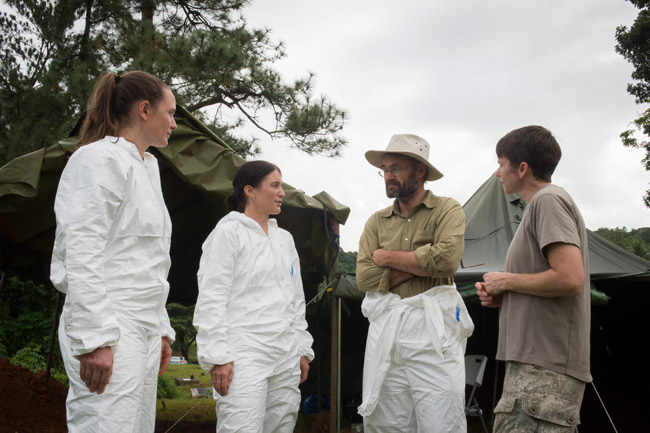Wednesday 16 May 2018 1:26pm

Pictured during their time in Suva, Fiji are (from left) Dr Rebecca Kinaston, Dr Rachel Scott, Dr Peter Petchey, and Lt Col Charmaine Tate. Photo: NZDF.
A team of University of Otago archaeologists and bioarchaeologists are putting their skills to tangible use in a New Zealand Defence Force (NZDF) repatriation mission.
Professor Hallie Buckley (of Anatomy) and Dr Peter Petchey (of Anthropology and Archaeology) are heading the forensic anthropology contingent of project Te Auraki (The Return) under which NZDF personnel buried overseas after 1 January 1955 are being brought home to New Zealand.
“From my perspective, this project offers a rare opportunity for myself and the team from the University of Otago to use our skills as bioarchaeologists in a tangible way to assist our country and the families of the service people who have been, and will be, returned home,” Professor Buckley says.
"We feel extremely privileged and humbled to be part of this mission."
“We feel extremely privileged and humbled to be part of this mission.”
So far, Royal New Zealand Air Force (RNZAF) Secretarial Officer Flight Lieutenant George Beban, MBE, Fireman Leading Aircraftman Ralph Scott, from Fiji, and Royal New Zealand Navy (RNZN) Engineering Mechanic 1st Class Russell Moore, from American Samoa have been returned to New Zealand.
Drs Peter Petchey, Rachel Scott and Rebecca Kinaston, all members of the Otago team, assisted with the exhumation process.
Flight Lieutenant Beban died in 1956 and Leading Aircraftman Scott died in 1960 in Fiji. Both died from natural causes and both were buried at the Suva Military Cemetery.
Navy Engineering Mechanic Moore, serving on HMNZS Lachlan died in an accident in 1956 in Pago Pago, American Samoa and was buried there.
Their remains were handed over to their families at a ramp ceremony at Ohakea Air Force Base earlier this month.
Group Captain Carl Nixon, who is leading Te Auraki, said the NZDF was committed to ensuring the process was as dignified as possible for the families of those being repatriated.
"It has also been valuable to work closely with current members of the services, providing an insight into their lives, and by association the lives of those that we are returning to New Zealand."
Each grave is blessed with kaumātua conducting karakia and other Māori protocols, and an NZDF military chaplain acknowledging the service of the personnel.
Once the remains have been identified, the service personnel being repatriated are never left alone, with a continuous vigil by NZDF personnel until they are given over to their families.
Dr Petchey says being involved in the project provides an “opportunity to use our skills in a new context and in a way that has very positive outcomes for the families of those who are being returned”.
“It has also been valuable to work closely with current members of the services, providing an insight into their lives, and by association the lives of those that we are returning to New Zealand,” he says.
Professor Buckley says the team will begin work in Malaysia and Singapore in July with 29 service personnel expected to be returned to New Zealand in August. Other sites they will work on include South Korea and the UK.
“The work in Malaysia will involve several weeks of physical work in extremely hot and humid conditions so managing the team’s health will be important. The NZDF are extremely organised and well-resourced so we don’t anticipate any problems,” she says.
